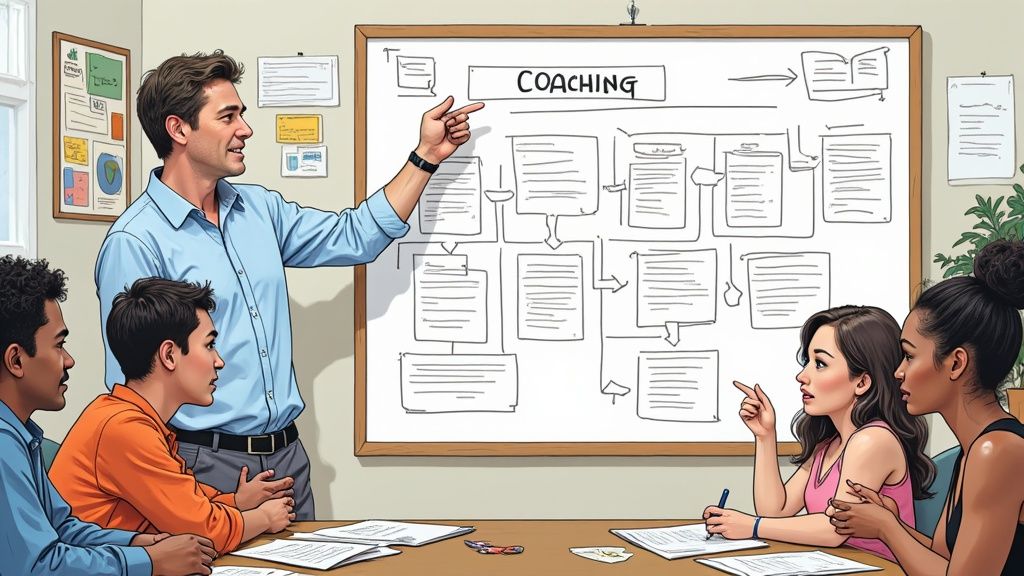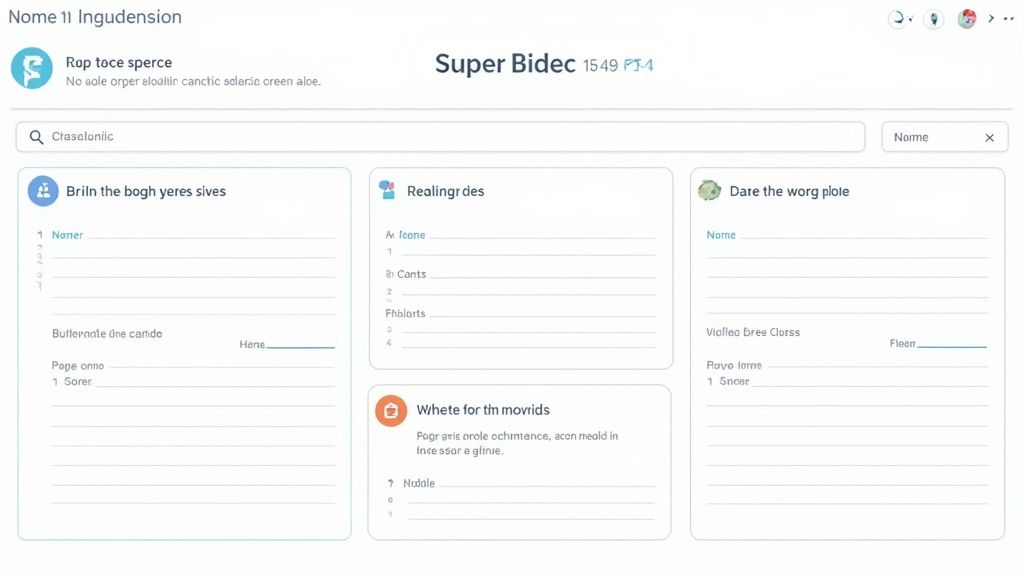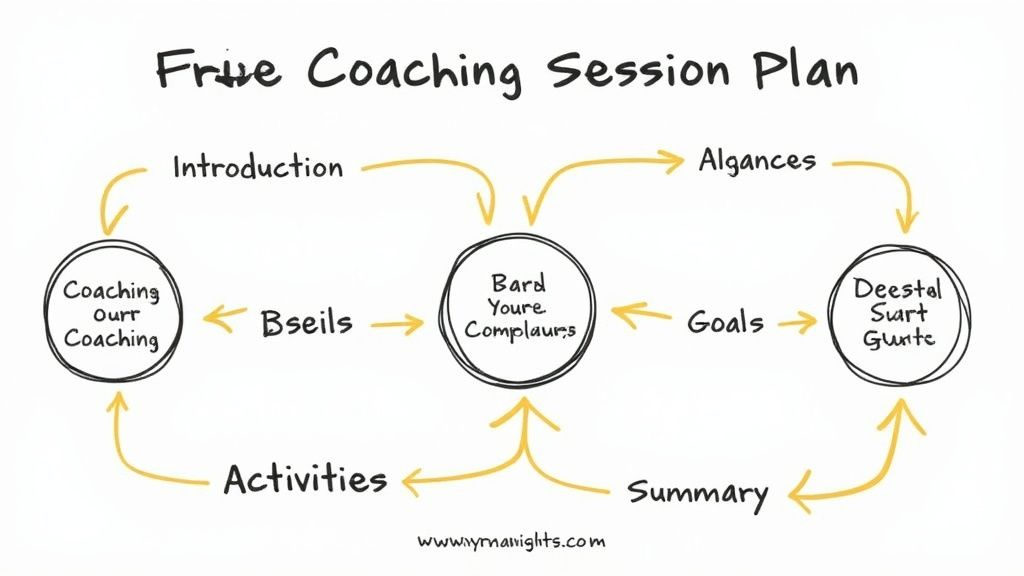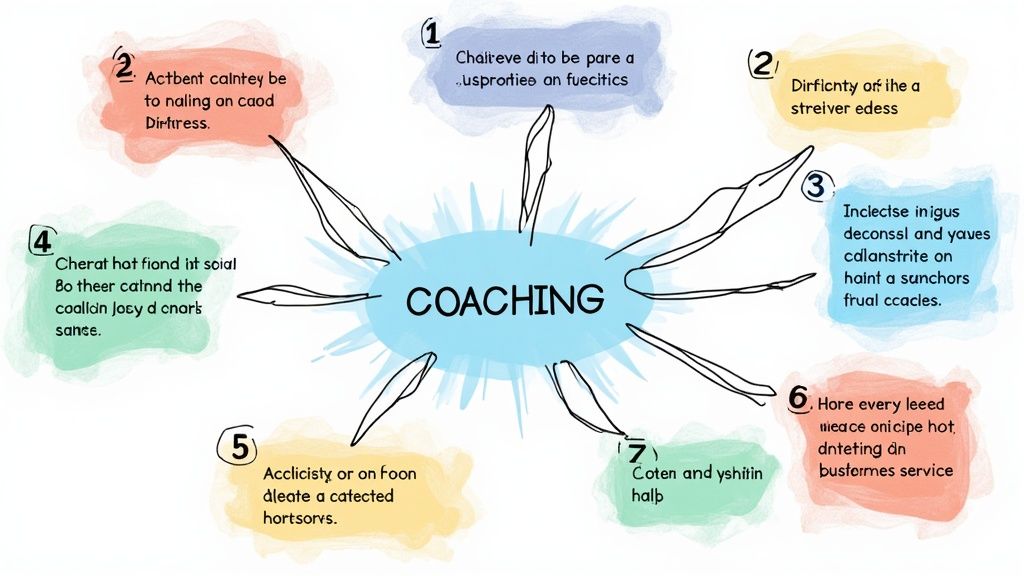The Ultimate Coaching Session Plan Template: Transform Your Practice With Proven Frameworks


Understanding The Power of Strategic Session Templates

The best coachs know that great sesions don't hapen by chance - they requir careful planing and structre. A well-designd coaching sesion templat serves as a vital foundaton, helping turn scattred discusions into focued, results-driven metings. By folowing a proven framwork, coachs can consistntly delivr meaningful insigts and guide clients toward their goals.
Streamlining for Success: Efficiency and Client Outcomes
Session templates make a huge difference in how efficiently coaches can work. Picture managing multiple clients, each with different needs and objectives. Without a clear structure, valuable time gets lost in admin tasks and disorganized meetings. A good template provides a reliable framework that simplifies everything from initial client assessment to progress tracking. This lets coaches spend more time on what really counts: building relationships and facilitating growth.
The benefits extend directly to clients too. Having a structured approach means each session has clear purpose and direction. Clients better understand their progress, stay motivated, and actively work toward their goals. The template also builds in accountability, keeping both coach and client focused on desired outcomes. This leads to real results and stronger working relationships based on trust.
The Psychology of Effective Session Structuring
The value of coaching templates isn't just practical - it's backed by psychology. Having a consistent structure creates predictability and control, which helps clients feel safe exploring challenges and new perspectives. Templates also make it easier to set SMART goals (Specific, Measurable, Achievable, Relevant, Time-bound), a key part of effective coaching. For instance, templates help organize information and highlight main development areas. Learn more about coaching session plan templates and how they support goal-setting and accountability.
From Basic Conversation to Strategic Transformation
A well-designed session template takes coaching beyond basic discussion. It becomes a tool for meaningful change, guiding clients through self-discovery, goal-setting, and concrete action plans. This approach helps clients achieve immediate goals while building skills for ongoing growth. The focus on lasting development is what sets apart truly impactful coaching experiences.
Building Your Perfect Session Template: Essential Components That Drive Results
A coaching session plan template forms the foundation of effective coaching practice. A thoughtfully designed template helps track progress, maintain consistency, and create meaningful change for clients. When building your template, focusing on key elements that support client growth while maintaining flexibility for different coaching scenarios is essential.
Key Elements of a High-Performing Template
Every effective template starts with clear objectives to guide each session. Having well-defined goals helps both coach and client stay focused on what matters. The template should also include dedicated space for client input - their reflections, challenges, and insights. This collaborative approach helps clients feel ownership of the process.
Key sections to include:
Session Focus: A clear statement of the main topic or theme
Action Planning: Specific steps the client will take between sessions
Progress Review: Notes on key milestones, wins, and growth areas
Balancing Structure With Spontaneity
While structure provides a helpful framework, leaving room for organic conversation and exploration is important. A typical session opens with a 10-15 minute check-in period for reviewing progress or orienting new clients to the process. Learn more about session structure here. Think of your template like sheet music - it guides the overall flow while allowing space for improvisation based on what emerges.
Adapting Your Template
Great templates can flex to support different coaching approaches. For example, a cognitive behavioral coaching (CBC) template may emphasize thought patterns and behavior change, while a strength-based coaching template focuses on building from existing capabilities. Choose elements that align with your coaching philosophy and methodology.
Client-Centric Design: Tailoring for Impact
At its core, your template should serve your clients' needs and goals. Regularly gather feedback on what's working well and what could be improved. Use this input to refine your template over time. A well-designed coaching session plan template provides structure while remaining flexible enough to meet each client where they are and guide them toward their desired growth.
Mastering Progress Tracking and Client Accountability

Having a structured coaching session plan template is essential for measuring progress and ensuring clients stay committed to their goals. By tracking key metrics and milestones, coaches can show real results while keeping clients motivated throughout their development journey. Let's explore how to turn your session template into an effective tool for monitoring growth.
Documenting Breakthroughs and Addressing Challenges
Successful coaches know that careful note-taking matters. Each session provides insights into how clients are growing - from small wins to major breakthroughs. When you record these details in your template, you create a clear picture of their journey. For instance, noting when a client overcomes a specific obstacle or reaches a goal, no matter how minor, builds positive momentum. Similarly, documenting struggles helps you tackle roadblocks head-on and shows clients you're invested in their success.
Maintaining Momentum Between Sessions
Your session template does more than guide individual meetings - it helps clients stay focused between sessions. By clearly outlining action steps and expectations, coaches keep clients moving toward their goals even when they're not meeting face-to-face. This steady progress builds lasting change. Starting each new session by reviewing the previous template's notes and assignments creates smooth transitions and reinforces follow-through.
Showcasing Progress and Strengthening Accountability
A coaching log template is particularly valuable for tracking development over time. Think of it as your client's growth record - capturing goals, techniques used, session summaries, feedback, and next steps. Learn more about maintaining a coaching log template. These detailed notes help demonstrate client progress while setting clear expectations for continued growth.
Building a Case for Continued Engagement
The information gathered in your session template provides solid evidence of coaching's impact. When you can point to specific examples of progress, you make a strong case for continuing the coaching relationship. This fact-based approach highlights the real benefits clients receive. Even more importantly, seeing their documented progress often motivates clients to invest further in their personal development.
Will rewrite while maintaining the informative tone and following the natural flow guidelines:
Streamlining Your Practice: From Template to Automated Success

Successful coaches know that using coaching session plan templates helps deliver consistent, high-quality service to clients while freeing up valuable time. By having a structured approach, coaches can focus their energy on what matters most - helping clients achieve meaningful results through personalized guidance and support.
Integrating Templates Into Your Workflow
The key to getting the most from templates is incorporating them naturally into your existing process. Start by identifying the most common types of sessions you conduct, like initial consultations or progress reviews. Then develop templates for each scenario. While it takes some upfront work, having these templates ready will save significant time later by providing a clear framework for each session type.
Automating Routine Tasks
With your core templates in place, look for opportunities to automate administrative work. Many modern coaching platforms include features for scheduling, reminders, and pre-session forms. This not only saves time but also creates a smooth, professional experience for clients. When routine tasks run automatically, you eliminate the risk of missed steps or inconsistent communication.
Creating Systematic Processes
A successful coaching practice runs on reliable systems, with templates serving as the foundation. Think of templates as your blueprint - they provide essential structure while leaving room to customize each session for individual clients. For example, having standard formats for intake forms, goal-setting exercises, and progress tracking helps maintain quality while reducing administrative work. This allows you to dedicate more energy to actual coaching conversations.
Enhancing the Client Experience
All these elements work together to create an excellent experience for your clients. When administrative processes run smoothly, you can focus fully on understanding and supporting each person's unique needs. Clear communication and consistent follow-through help build trust, while structured progress tracking keeps clients motivated and engaged. This combination of efficiency and personalization leads to better results and long-term success for both coach and client.
Customizing Templates for Maximum Impact Across Coaching Specialties
Every client and coaching situation requires its own thoughtful approach. While starting with a basic coaching session plan template provides a good foundation, achieving real impact means adapting your methods to match specific client needs and coaching disciplines.
Tailoring Templates for Different Coaching Disciplines
Different coaching focuses demand different approaches in your session planning. An executive coaching session typically concentrates on building leadership abilities and strategic thinking, with dedicated sections for analyzing business challenges. In contrast, life coaching sessions often explore personal growth areas like values, relationships and work-life integration, requiring space for emotional exploration and personal goal-setting.
Group Coaching vs. Individual Coaching
Group and individual coaching each have distinct dynamics that need different template structures. Group sessions thrive on peer interaction and shared learning, so templates should include time for group discussions and team exercises. Individual sessions allow for deeper personal exploration, requiring sections focused on the client's specific challenges and aspirations.
Specialty Niches and Client Needs
Each coaching discipline contains many specialized focus areas. For instance, a health coach works with clients on nutrition and fitness goals, needing sections to track dietary habits and exercise progress. A career coach helps clients with job searches and professional development, requiring space to monitor application progress and networking activities. Even within these niches, some clients need more structured approaches while others prefer flexibility.
Maintaining Core Elements While Customizing
While adapting templates for different situations, certain essential components should remain consistent:
Clear Objectives: Begin each session with defined goals that both coach and client understand
Action Planning: Include space for specific steps clients will take between sessions
Progress Review: Track and evaluate client advancement to celebrate wins and identify growth areas
This consistent framework provides stability while allowing for customization based on specialty and client needs.
Real-World Examples and Practical Tips
Consider how different coaches adapt their templates: A business coach might add a SWOT analysis section, while a life coach focused on time management could incorporate time tracking exercises. Regular template reviews based on client feedback help ensure your approach stays effective. Making these practical adjustments keeps your coaching relevant and impactful for each unique situation.
Implementation Excellence: Your Blueprint for Template Success

Making a coaching session plan template work effectively takes more than just creating a document. Success comes from carefully integrating templates into your practice in a way that fits your personal coaching approach. Here's a practical guide to help you get the most value from your templates.
Choosing the Right System: Digital or Paper?
Start by deciding between digital and paper formats based on your needs. Paper templates give you the ability to write freely and connect with clients through handwritten notes. Digital templates excel at organization, editing, and sharing information seamlessly. Many coaches find success using both - digital for admin work and paper for session notes. Consider what will work best for your coaching style and client preferences.
Integrating With Coaching Software
For digital templates, smooth integration with your existing tools is key. Most coaching platforms let you import your custom templates, making it simple to access client info, schedule meetings, and share materials in one place. Some systems can even send automatic reminders and track follow-up tasks to keep clients engaged between sessions.
Gaining Client Buy-In
Getting clients on board with templates makes a big difference in their success. Take time to explain how templates help them reach goals more effectively by maintaining focus and documenting progress. Ask for their input on the template design and make adjustments based on their feedback. When clients feel ownership of the process, they're more likely to stay engaged.
Step-by-Step Implementation Plan
Breaking down template implementation into clear phases makes it manageable:
Phase 1: Template Creation and Testing: Design your template and test different versions with a small client group
Phase 2: Software Integration and Training: Set up digital templates in your system and learn to use them efficiently
Phase 3: Client Introduction and Feedback: Roll out templates to all clients with clear explanations and gather input
Phase 4: Ongoing Refinement: Regularly review and update templates based on what you learn from actual use
Troubleshooting Common Challenges
Watch for these typical issues and address them early:
Client Resistance: Some clients may hesitate to use templates. Listen to their concerns and adjust the approach to fit their needs
Technical Issues: Ensure everyone can easily access and use digital tools. Have backup options ready if technology fails
Template Overload: Keep templates simple and focused on essential information. Remove unnecessary elements that cause confusion
By following these practical steps, you can smoothly introduce templates that enhance your coaching practice. Well-designed templates help both you and your clients stay focused and achieve better results.
Ready to take your coaching to the next level? Visit Coaching Hub for more tools and resources to grow your practice.